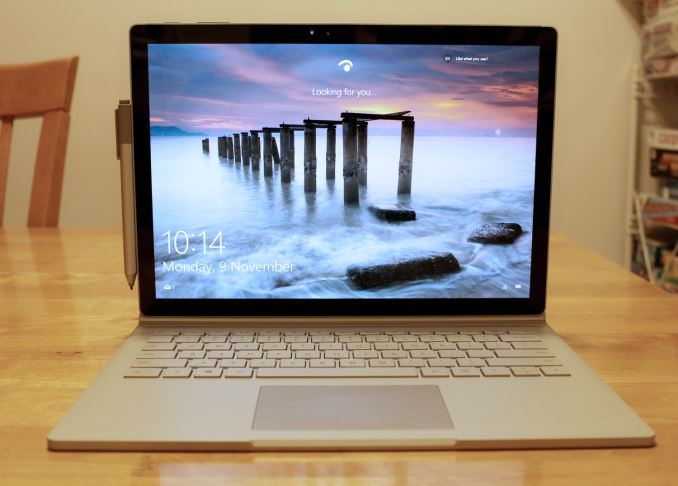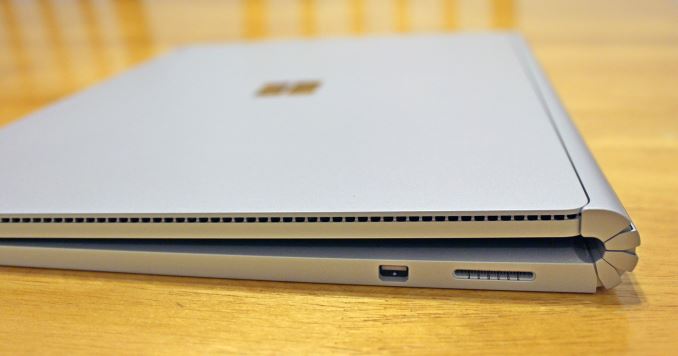The Microsoft Surface Book Review
by Brett Howse on November 10, 2015 8:00 AM EST
When Microsoft first launched the Surface Pro, they decided to tackle a market that was pretty much untested. Sure, tablets had been around for a while already, but no one had packed a full Ultrabook inside of a tablet. True, the initial Surface Pro had some compromises made due to the hardware available at the time, but Microsoft started to build a brand with Surface, a brand that they lifted from another product line altogether. It’s taken a few generations for the hardware to catch up with that original vision, but I think it’s fair to say that the Surface Pro tablet line has solidified itself as the Windows tablet to beat. The build quality, materials, and performance, are really second to none at this time.
I’m talking about branding because it’s one of the most difficult parts of a new product lineup. Microsoft, perhaps more than most companies, has certainly had its struggles with branding over the years. Surface though, has truly been defined, and molded, and evolved, into a strong brand for the company, and it plays right at the high end. And that brings us to Surface Book. Surface Book is an extension of the Surface brand, and Microsoft now wants to try its hands at the laptop market. Their goals for Surface Book are certainly not the same as they were for the original Surface Pro, since the laptop market is already well defined, and there are already many excellent devices available. For Microsoft to throw their hat in the ring in this segment is a much different proposition than before, and to succeed, as well as to continue to evolve the Surface brand, they set out to build what they are calling “The Ultimate Laptop”.
Surface Book certainly keeps the tradition of Surface alive and well. The 13.5-inch laptop has the same 3:2 aspect ratio of the rest of the Surface line, and it is built out of magnesium with the same finish. The fit and finish is very high, and the entire device feels as premium as it should. I think the defining feature of the Surface tablet lineup is the kickstand, and with the Surface Book it is most certainly the hinge. The hinge on the Surface Book is truly unlike anything ever used on a notebook computer before, and while it may not be to everyone’s taste, it certainly draws comments. The hinge, other than a design element, brings a lot of function to the party as well, with it being a key component to keeping this laptop balanced correctly. Balance is generally not an issue with laptops, but the Surface Book has another trick up its sleeve – the display detaches. The Surface Book is hardly the first device to do this, but it is one of the few that has tried to tackle the balance problem with 2-in-1 devices where the screen detaches, and the hinge is a key component to that. Microsoft calls it a Dynamic Fulcrum Hinge, and it extends the base of the laptop slightly to give it more leverage over the display section.
The design is unique, and what is inside is unique as well, at least potentially. There are two models of the Surface Book. The first model is a typical Ultrabook inside, with an Intel Core i5-6300U processor, but the second model is the only detachable laptop which also has a discrete GPU. There are a couple of reasons this has never been done before, with the main reason being it’s very difficult to dissipate the extra heat that a GPU brings to the table. Microsoft has designed the Surface Book with a GPU which lives in the keyboard base, with the rest of the required components behind the display. This gives them two thermal zones, and by moving the GPU to the base like this, it lets the Surface Book cool the CPU and GPU independently. The extra space in the keyboard is then packed with batteries.
| Surface Book | |||
| Core i5 | Core i5 w/GPU | Core i7 w/GPU | |
| GPU | Intel HD 520 | Intel + "NVIDIA GeForce" (Approx. GT 940M) w/1GB GDDR5 |
|
| CPU | 6th Generation Intel Core i5-6300U (15w) | 6th Generation Intel Core i7-6600U (15w) | |
| Memory | 8-16GB RAM | ||
| Display | 13.5" IPS 3000x2000 resolution 1800:1 Contrast Ratio 100% sRGB, individually calibrated 10 point touch and Pen support |
||
| Storage | PCIe 3.0 SSD 128 GB to 1 TB | ||
| I/O | USB 3.0 x 2 (In Base) SD Card reader (In Base) Surface Connector (In Tablet and Base) Headset Jack Mini DisplayPort |
||
| Dimensions | Laptop (mm) : 232 x 312 x 13.0-22.8 (inches) : 9.14 x 12.3 x 0.51-0.90 Tablet Only (mm) : 220.2 x 312.3 x 7.7 (inches) : 8.67 x 12.3 x 0.30 |
||
| Weight | Laptop 1.515 kg / 3.34 lbs Tablet Only 726 g / 1.6 lbs |
Laptop 1.579 kg / 3.48 lbs Tablet Only 726 g / 1.6 lbs |
|
| Camera | Windows Hello (Front) 8 MP Rear Facing 5 MP Front Facing |
||
| Price | $1499+ | $1899+ | $2099+ |
Looking at the specifications, one thing to point out is the battery capacity. Most Ultrabooks would average somewhere around 50 Wh of capacity, with a few somewhat higher and a few somewhat lower. By combining the battery in the tablet, which Microsoft calls the Clipboard, with the base, the Surface Book has an amazing 70 Wh of battery capacity. This should help out on battery life, assuming the 3000x2000 display doesn’t drag that down. The rest of the Surface Book is pretty similar to the Surface Pro 4, with PCIe NVMe storage options up to 1 TB, and touch and pen support via the PixelSense display. There are also two USB 3.0 ports in the base, along with a DisplayPort output, and the Surface Connect port which is used for charging, as well as connecting the Surface Dock. There are no ports on the Clipboard at all, with the exception of the Surface Connect port, so if you are using the Clipboard on its own, you will have to dock it to access USB. Like the Surface Pro 4, it would have been nice to see a USB Type-C port included, and the Clipboard would be a perfect spot for that.
Microsoft is calling the Surface Book “The Ultimate Laptop” and that is a pretty lofty goal for a first generation product. In this review, we will examine all aspects of the Surface Book and see how they compare to the best laptops around. Let’s start with the design.











249 Comments
View All Comments
zeeBomb - Thursday, November 12, 2015 - link
Let's go for 200.solipsism - Tuesday, November 10, 2015 - link
Ah, you are correct, djboxbaba.KoolAidMan1 - Tuesday, November 10, 2015 - link
The current 13" Macbook Pros are Broadwell, not Skylake. 28w Skylake parts aren't out until Q1 2016.tipoo - Tuesday, November 10, 2015 - link
Solandri, now you're talking about the 13" MBPs CPU, after giving the 15" with dGPUs pricing...The 15" which we were talking about has a full wattage laptop quad. Your points are starting to look a little suspect as you mix and match a lot. Surface Book without dGPU pricing compared to the upgraded 15" MBP with GPU for price, and then the 13" MBPs CPU when that's convenient to talk about...Look at the Surface Books price WITH the dGPU, which I already specified before, and then match the storage and RAM of the 15" MBP, and the prices start to look similar, except with a quad core vs a dual. And the baseline Iris Pro gets close to the 940M performance as well.
Solandri - Wednesday, November 11, 2015 - link
tipoo, how am I mixing and matching? I looked at the top SB which has a dGPU at $2099, and compared to the top 13" MBP and top 15" MBP (with dGPU), and the SB pricing is closer to the 13" MBP. If you compare models without dGPU, it's even closer to the 13" MBP.Lowest-end 13" rMBP on Apple's website - $1299
Lowest-end SB w/o GPU - $1499
Lowest-end 15" rMBP w/o GPU - $1999
And the Iris Pro 6100 performance doesn't come anywhere near the 940m (except for OpenGL, which is important for OS X, but not for Windows or games). The 940m is roughly 2x as fast.
http://www.notebookcheck.net/Mobile-Graphics-Cards...
http://www.notebookcheck.net/Computer-Games-on-Lap...
Darkstone - Tuesday, November 10, 2015 - link
You can't compare processors with different TDP's by their clock speeds. My 45W CPU isn't able to sustain it's turbo clock under most 100% workloads, on rare workloads it will even drop below it's stock clocks without using the GPU. On those rare workloads it's slower than an on paper lower specced i5 desktop CPU purely because the TDP is higher.The i5-5287U in the MBP will require about 21W to sustain turbo clocks under AVX workloads (according to notebookcheck's stress test). Any 15W part will be significantly slower regardless of what intel claims what the clock speeds are.
Riley-NZL - Tuesday, November 10, 2015 - link
Your also comparing an OSx device with a Windows device, the later being infinetly more valuable regardless of hardware specs :Ptipoo - Tuesday, November 10, 2015 - link
You can run both on the former. But anyways, the value of the OS is subjective per user, that's a meaningless thing to say.theuglyman0war - Wednesday, December 2, 2015 - link
true considering the first thing I do when I demo the newest Surface at the Brick n Mortar is to see how accurate and responsive the pen pressure is.During these arguments I think the army of creative types who hunger for the niche these products offer are hugely ignored.
Billie Boyd - Friday, November 27, 2015 - link
While the Microsoft Surface is truly fantastic , there are higher rated ones, believe it or not (see http://www.consumerrunner.com/top-10-best-tablets/ for example..)